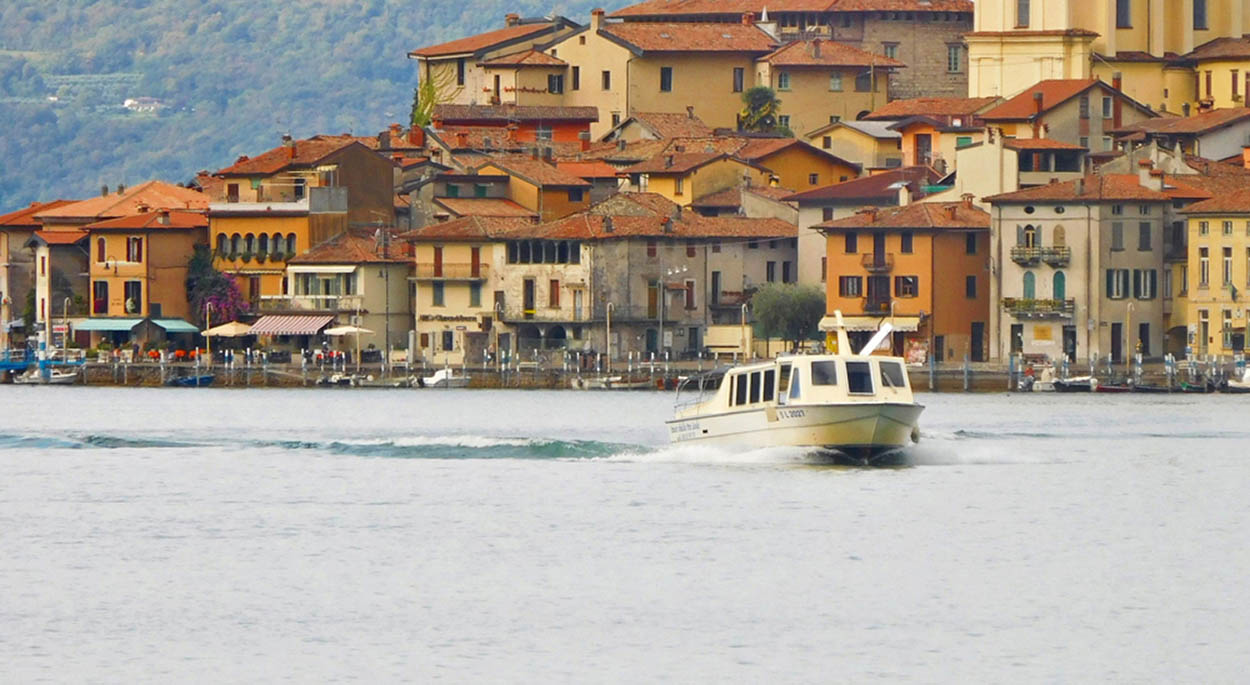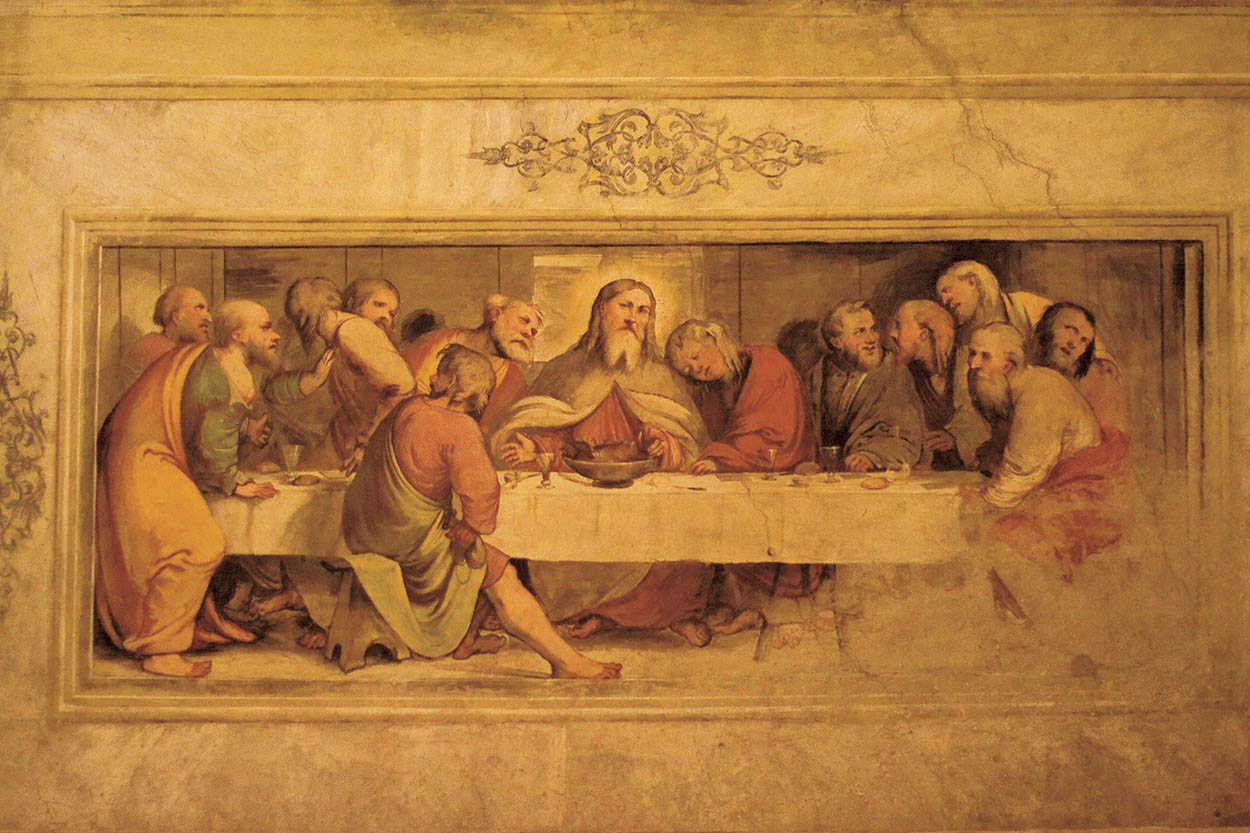
Explore the town of Iseo before cruising to the lovely island of Monte Isola for a lakeside stroll and lunch. An afternoon tour of the lake takes in the wild western shore and lakeside villages that retain their medieval core.
DISTANCE: Driving tour: 72km (45 miles)
TIME: A full day
START/END: Iseo
POINTS TO NOTE: Check timetables on www.navigazionelagoiseo.it. The tour of the lake by car is also lovely by ferry.
Unfairly neglected in favour of the larger lakes, Lake Iseo (Lago d’Iseo) is more tranquil and less self-consciously quaint. The lake is short on the beautiful attractions that are a hallmark of the other lakes, but compensates with a gentler way of life, fine walks and a delightful unspoilt island to explore.
The best base from which to explore the lake is Iseo 1 [map], an attractive historic town that has not completely sold out to tourism. Until the 1870s, it was a significant port that shipped grain from Valle Camonica and steel from the industrial lakeside ports. Today it is a commercial town on a smaller scale. Sandwiched between the waterfront and the feudal Castello Oldofredi, it retains its cosy medieval street pattern and an elegant lakeside promenade.

View of Monte Isola from the water
Shutterstock
Historic centre
The liveliest part of town is the porticoed Piazza Garibaldi, dominated by a statue of the great patriot perched on a mossy rock – this is one of the few horseless statues of the Risorgimento leader. In Piazza Mazzini, reached by a narrow alley, you can see old stone washtubs and the Arsenale that today serves as an art exhibition venue. Take Via Sombrico and Via delle Pieve for the church of Sant’Andrea. Although clumsily remodelled, it has the finest Romanesque bell tower in the region. To the southwest, the restored 15th-century Castello Oldofredi is set on a mound and is home to the little Museo delle due Guerre (closed for refurbishment at the time of writing, for updates see http://visitlakeiseo.info/en/arts-and-culure/the-two-wars-museum), where two rooms house equipment used in World Wars I and II, including military uniforms, firearms and hand grenades.
Lake Iseo

Return to Piazza Garibaldi and make for the lakeside, where you can take a relaxing ferry ride to Peschiera Maraglio 2 [map] on Monte Isola, usually the second stop. The mountainous, densely forested island – the largest lake island in Europe – supports a 200-strong community of fishermen, boatbuilders and net-makers.
Car-free island
The pace of life is palpably slow here: private cars are banned (though local motorbikes are not) and a minibus service connects the various hamlets. The fishing hamlets reveal refined touches, from sculpted portals to tiny courtyards and loggias. Above, tiers of olive groves merge into vineyards and chestnut groves. The highest peak is surmounted by the 16th-century Santuario Madonna della Ceriola, built over a pagan shrine.
Lunch at Peschiera Maraglio
Choose a typical lakeside haunt at Peschiera Maraglio (which is also known simply as ‘Peschiera’) for an outdoor lunch. After you have had your fill of grilled sardines, perch risotto and lake scampi, check out the cluttered shop on the waterfront that sells fishing nets and hammocks: net-making is an integral part of life on the island. An industry thought to have been initiated by Cluniac monks 1,000 years ago now embraces Wimbledon tennis nets and World Cup football nets. Depending on the season and time of day, there may be signs of boatbuilders at work or fishermen laying their catch out to dry in the sun.
Peschiera to Sensole
The best gentle walk from Peschiera west is along the lakeside path to Sensole 3 [map], taking in views of competent swimmers competing for attention with struggling ducks. Both hamlets are set on the sunny side of Monte Isola, and the view encompasses the tiny island of San Paolo with the town of Iseo melting into the background. If you have not already eaten, you might consider La Spiaggetta, see 1 [map], between the villages. The alternative to walking is to hire a bike at Peschiera – you can cycle round the whole island in about fifty minutes.
Catch the ferry back to Iseo, then take a scenic drive clockwise around the lake (following signs west to Sarnico) to see Riva di Solto’s rugged western shore in Bergamo province.
Clusane
Just to the west of Iseo, Clusane 4 [map] is a food-lover’s paradise: on the waterfront there are fine fish restaurants that specialise in baked tench. Crowned by a castle, Clusane overlooks a busy port full of traditional red- and yellow-rimmed fishing boats setting out in search of tench, pike, chub and lake sardines. The village borders wine-growing Franciacorta, and its hinterland is dotted with inns. You may wish to return to Clusane for dinner.

Marone town on Lake Iseo
Shutterstock
Sarnico to Riva di Solto
The first resort on the western shore (5km/3 miles), Sarnico occupies the site of a prehistoric stilt village and owes much of its character to the ruined medieval ramparts and graceful loggias. But it is best known for its speedboat companies that support one of the lake’s premier activities.
Follow the lakeshore road for 20.5km (12.75 miles) to Riva di Solto. From over-quarried Tavernola Bergamasca to Riva di Solto lies the most dramatic stretch of the western shore, with coves carved into limestone cliffs and sheer ravines running down to gnarled rocks. These jagged formations reputedly inspired Leonardo da Vinci’s Virgin of the Rocks and possibly the Mona Lisa.
Riva di Solto 5 [map] is a pretty fishing hamlet full of alleys and arches, with placid views across to the domesticated shore of Monte Isola.
Lovere
After 7km (4.5 miles) is Lovere 6 [map], dominating the northern end of the lake. Originally a Venetian textile town, Lovere turned to steel then watersports tourism. Stroll along the waterfront with its lakeside cafés and restaurants, and then explore the historic core with its narrow alleys, medieval towers, castle remains and the frescoed Renaissance church of Santa Maria in Valvendra.
On the lakefront, the Neoclassical Palazzo Tadini is home to the Galleria dell’Accademia Tadini (www.accademiatadini.it; charge), displaying works of the Lombard and Venetian schools, including Tintoretto, Jacopo Bellini and Giandomenico Tiepolo.
The eastern shore is less peaceful, and between Pisogne and Marone you will be driving through tunnels. Pisogne can be clearly seen across the water from Lovere but has to be accessed by taking the main Via Nazionale (SS42) north, beyond the northern tip of the lake, and then heading south along the SP55, signposted to Pisogne.
Pisogne
The former arms-manufacturing town of Pisogne 7 [map] was a centre of commerce for the whole valley in medieval times, and retains an appealing historic centre. The main square is the spacious Piazza del Mercato, overlooking the lake and flanked by arcades. Looking onto the square is the medieval Torre del Vescovo (Bishop’s Tower), where (according to one of the rather finely illustrated information panels in the town centre) those who defaulted on taxes were hung in a cage fixed to the tower, and where, in 1518, eight women accused of witchcraft were imprisoned before being burned alive in the square.
North of Lake Iseo, the Camonica Valley (Valle Camonica, www.turismovallecamonica.it; free) has been inhabited since the Neolithic era. As long ago as 8,000 BC, hunters were recording scenes of everyday life by carving on the smooth sandstone rocks of the valley floor. Some 180,000 etchings have been discovered, constituting the greatest concentration of prehistoric rock carvings in Europe. These are scattered all along the valley, but the best examples are contained within Capo di Ponte’s Parco Nazionale delle Incisioni Rupestri (National Park of Rock Engravings; www.parcoincisioni.capodiponte.beniculturali.it; free), a Unesco World Heritage Site.
Although the Camonica Valley is nowadays partially marred by industry, the park is rural and wild, with birch and pine woods. The primitive carvings span several thousand years, from Stone Age scratchings to Bronze Age narratives to Roman graffiti. Animals – from Etruscan boxer dogs masked as cockerels to elk speared by hunters and deer caught in lassoes – feature prominently. However, unless you are an expert or have booked a guide (www.guideturisticheilmosaico.com), the mysteries can be hard to decipher, and the routes are not as clearly marked as you might expect from a World Heritage Site.

Lake fish hanging out to dry
Shutterstock
1 [map] La Spiaggetta
Via Sensole 26, Monte Isola, www.facebook.com/LaSpiaggettawakeclub
This little family-run trattoria serves coffees, light food – including excellent sandwiches – and drinks on the lakeside path between Sensole and Pescheria Maraglio. €
Chiesa di Santa Maria della Neve
On the outskirts of the town (follow signs for ‘Affreschi del Romanino’), the church of Santa Maria della Neve (www.visitlakeiseo.info/en/arts-and-culure/church-of-santa-maria-della-neve; free) is known as ‘La Cappella Sistina dei Poveri’ (the Poor Man’s Sistine Chapel) on account of the striking frescoes covering the walls and ceiling. Depicting scenes from The Passion of Christ, the works are by Romanino (c.1484–1559), a leading Brescian Renaissance artist known for his realistic portraits – which can be found all around Lake Iseo.
Zone Nature Reserve
Continuing 10km (6.25 miles) south along the lake you come to Marone, overlooking the diminutive, privately owned Isola di Loreto (Loreto Island), where trees cluster around a castle.
A twisting road inland from here takes you to Zone (7km/4.25 miles), a picturesque village renowned for the Riserva Naturale Piramidi di Zone 8 [map]. This unique formation of ‘erosion pillars’, created by uneven glacial erosion, is the finest example in Europe. Their most unusual features are the boulders that are precariously perched on top, looking like hats. The best views of these ‘stone fairies’ (as the locals call them) is at Cislano, before you get to Zone.
Dinner options
Return to Marone and follow the road south for Iseo (13km/8 miles) to complete the circuit.
For dinner, shoot past Sulzano, unless you intend to take the ferry back to Monte Isola for another fish feast (the ferry only takes fifteen minutes from here). Clusane is a better bet than Iseo for dining out. A good option is Punta dell’Est . Alternatively, walk or drive inland from Clusane 1.5km (1 mile) for the enchanting Relais Mirabella , signposted from the main road.
Another lovely setting with first-class food is the Relais I Due Roccoli , at Polaveno, 12km (7.5 miles) east of Iseo.

Fresco of ‘The Last Supper’ in the church of Santa Maria della Neve in Pisogne
Neil Buchan-Grant/Apa Publications